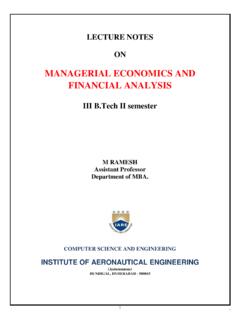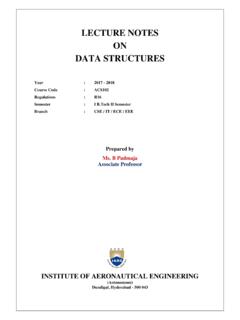Transcription of RENEWABLE ENERGY SOURCES
1 LECTURE NOTES ON RENEWABLE ENERGY SOURCES IV B TECH II Sem JNTUH - R15 Mr. G Saratraju, Assistant Professor Mr. A Venuprasad Assistant Professor MECHANICAL ENGINEERING INSTITUTE OF AERONAUTICAL ENGINEERING (Autonomous) DUNDIGAL, HYDERABAD - 500 043 UNIT I PRINCIPLES OF SOLAR RADIATION RENEWABLE ENERGY is generally defined as ENERGY that comes from resources which are naturally replenished on a human timescale such as sunlight,wind,rain,tides,waves and geothermal heat. RENEWABLE ENERGY replaces conventional fuels in four distinct areas: electricity generation,hot water/space heating, motor fuels, and rural (off-grid) ENERGY services. RENEWABLE ENERGY is derived from natural processes that are replenished constantly. In its various forms, it derives directly from the sun, or from heat generated deep within the earth.
2 Included in the definition is electricity and heat generated from solar, wind, ocean, hydropower, biomass, geothermal resources, and biofuels and hydrogen derived from renewableresources Introduction: The sun is the source of ENERGY that drives the cycle of life and death on earth. It is also the ENERGY source that gives us warmth and evaporates water and melts snow. The sun is about 150,000,000 km away from the Earth. Due to its immense, but finite size, it has an angular diameter of degree (32 minutes), as viewed from Earth. Sun burns continuously via thermonuclear reactions (fusion). Inside the sun, radioactive processes releases ENERGY and convection transfers solar ENERGY to its exterior surface.
3 Despite the extremely high temperatures needed at the core of the sun, to sustain its thermonuclear reactions, the sun has a black body temperature of 5770 K. Consequently, we receive a relatively constant flux density of ENERGY , defined as the Solar Constant. Its mean value is 1366 Wm-2. The earth receives 1018 units of ENERGY from the Sun annually, which is 20,000 times the requirement of mankind on the earth. Some of the solar ENERGY causes evaporation of water, leading to rains and creation of rivers etc. Some of itis utilized in photosynthesis which is essential for sustenance of life on earth. Man has tried, from time immemorial, to harness this infinite source of ENERGY , but has been able to tap only a negligibly small fraction of this ENERGY .
4 When light travels from outer space to earth, solar ENERGY is lost because of following reasons: 1. Scattering: The rays collide with particles present inatmosphere 2. Absorption: Because of water vapor there isabsorption 3. Cloud cover: The light rays are diffused because ofclouds. 4. Reflection: When the light rays hit the mountains present on the earth surface there is reflection. 5. Climate: Latitude of the location, day (time in the year) also affects the amount ofsolar ENERGY received by theplace. Solar Radiation geometry In Solar Radiation geometry the following terms are important: 1. Horizon is the horizontal plane that extends from the point where the observer is standing, to infinity ,straight through space. Since we're only working with relatively short distances (compared to the Universe), a line extending N-S will be quitesufficient 2.
5 Altitude (A) is the angle of the sun over the horizon. In this problem, we will be working with the sun atnoon, so it will either be over the N or Shorizon. 3. Zenith (Z) is the angle that the sun is from directly overhead, and it is equal to 90-A. It, too, can be over the S or N horizon, but there is little need to stateit. 4. Declination (D) is the latitude at which the sun is directly overhead. It is always N and , those occurring on theSolstices. 5. Latitude (L) is the location N or S of the equator at which the observer is located. (It is determined byradii from the centre of Earth at different angles to the equator. If such an angle is swept along the surface of the planet, it draws acircle.) Instruments for measurement of solar radiation A pyranometer is a device used to measure global solar radiation, while a pyrheliometer measures direct radiation.
6 A pyranometer is comprised of a thermopile sensor with a black coating, which absorbs all solar radiation, and a glass dome, which limits the spectral response of the thermopile. A pyrheliometer works similarly, but is designed with a solar tracker to keep the device directly aimed at the sun for the duration of the measurement being taken. Solar Radiation data Solar radiation data is necessary for calculating cooling load for buildings, prediction of local air temperature and for the estimating power that can be generated from photovoltaic cells. Solar radiation falling on the surface of the earth is measured by instruments called pyranometers. The weather service in most countries has many stations to measure solar radiation using pyranometers.
7 In India pyranometers have been used for a longtime. ENERGY Scenario Introduction Any physical activity in this world, whether carried out by human beings or by nature, is cause due toflow of ENERGY in one form or the other. The word ENERGY itself is derived from the Greek word enrgon , which means in-work or work content . The work output depends on the ENERGY input. ENERGY is one of the major inputs for the economic development of any country. In the case of thedeveloping countries, the ENERGY sector assumes a critical importance in view of the ever- increasing ENERGY needs requiring huge investments to meet them. ENERGY can be classified into several types based on the following criteria: Primary and Secondaryenergy Commercial and Non commercialenergy RENEWABLE and Non-Renewableenergy Conventional and Non-conventionalenergy Primary and SecondaryEnergy Major Primary and Secondary SOURCES Primary ENERGY SOURCES are those that are either found or stored in nature.
8 Common primary ENERGY SOURCES are coal, oil, natural gas, and biomass (such as wood). Other primaryenergysources available include nuclear ENERGY from radioactive substances, thermal ENERGY stored in earth's interior, and potential ENERGY due to earth's gravity. The major primary and secondary ENERGY SOURCES are shown in Primary ENERGY SOURCES are costly converted in industrial utilities into secondary ENERGY SOURCES ;for example coal, oil or gas converted into steam and electricity. Primary ENERGY can also be used directly. Some ENERGY SOURCES have non ENERGY uses, for example coal or natural gas can be used as a feedstock in fertilizer plants. Fig : The French chemist Lavoisier experimented with concentrating solar ENERGY using a large parabolic mirror.
9 Auguste Mouchout, inventor of the first active solar motor, questioned the widespread belief that the fossil fuels powering the Industrial Revolution in the 19th century would never run out. Prophetically he said: Eventually industry will no longer find in Europe the resources to satisfy its prodigious expansion. Coal will undoubtedly be used up. What will industry do then? In 1861, Mouchout developed a steam engine powered entirely by the sun. But its high costs coupled with the falling price of English coal doomed his invention to become a footnote in ENERGY history. Nevertheless, solar ENERGY continued to intrigue and attract European scientists through the 19th century. Scientists developed large cone-shaped collectors that could boil ammonia to perform work like locomotion and refrigeration.
10 France and England briefly hoped that solar ENERGY could power their growing operations in the sunny colonies of Africa and East Asia. Fig. : 1901 "solar motor" in operation in California. The solar furnace in Mont Louis, built in 1949 by Professor F lix Trombe, was the first solar furnace in the world. This dual reflection solar furnace has been in steady evolution over the past 50 years and in 1993, was taken over by the limited liability company "Solar Furnace Development" who, along with continued scientific research, is the first company to use a solar furnace for industrial and manufactured products such as the firing of ceramics, and bronze and aluminium products. Professor Trombelater (1969-1971) directed the design and the construction of the largest solar furnace in the world that we will discuss in detail.












